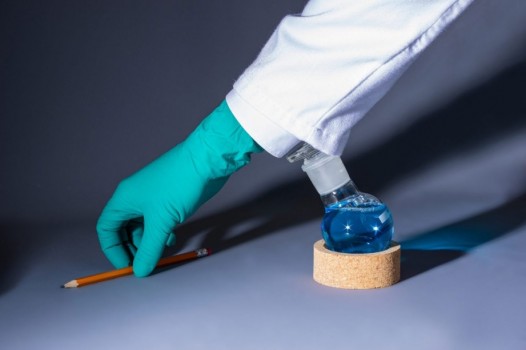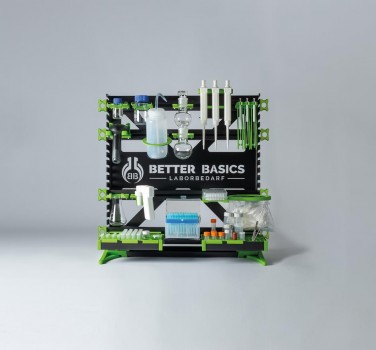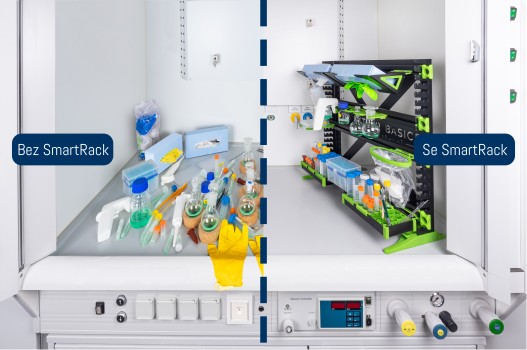Laboratory workspace organization – modular SmartRack® system for safe glassware holders and improved efficiency
Meeting the growing demands of modern laboratories
Today’s laboratories face increasing pressure – more samples, stricter regulations, and higher requirements for safety and reliable results. This applies not only to the pharmaceutical and biotech industries, where standards are extremely demanding, but also to chemical production, research institutes, and university laboratories.
While significant budgets are often spent on cutting-edge instruments, the organization of the laboratory workspace is frequently overlooked. Yet this is where many productivity losses and safety incidents originate – searching for tools, inconsistent layouts, and small deviations from standard procedures. Optimizing these aspects can be just as important as investing in high-end equipment.
Risks of conventional setups
Even well-equipped labs often rely on simple accessories for placing glassware and tools – various rings, supports, or stands. These provide only basic stability and protection. A single unexpected movement, a sleeve catching on an item, or working in a tight space can easily lead to spills, breakage, or contamination.
A common example is a round-bottom flask placed in a simple ring, which can easily tip over if touched. In teaching laboratories where students and less experienced users work, the risk of such incidents is even higher. Research labs, where team members frequently rotate and the environment is dynamic, also face challenges with maintaining consistent, predictable layouts.
Modular systems such as SmartRack® offer secure and stable fixation of laboratory glassware and tools, reducing the risk of accidents while improving workflow speed.
Secure fixation of round-bottom flasks and other glassware with SmartRack® prevents accidental tipping and improves workplace safety.
Modular organization for different laboratory environments
SmartRack® is a modular laboratory organization system developed by Better Basics Laborbedarf. It transforms workspaces from a historically grown mix of accessories into a clearly structured and ergonomic workstation.
Every element – from separatory funnels and round-bottom flasks to filters and pipettes – has its clearly defined, safe position directly at the bench. The modular design adapts to specific tasks and can be reconfigured easily when workflows change. Its smart vertical arrangement can free up to 80 % of valuable bench space compared to conventional setups.
Figure 3 – before / after comparison:
Typical sample preparation station: left – unstructured layout without SmartRack®, right – organized, safe modular setup with SmartRack®.
For laboratories that already have established benches, MERCI also provides special mounting rails that can be integrated into existing furniture. These allow the use of the same glassware holders and modular accessories without purchasing an entire freestanding system. MERCI supports planning and installation to ensure compliance with ergonomic and safety standards, enabling cost-effective modernization of laboratory workspace organization.
Internal study: up to 30 % greater efficiency
Better Basics Laborbedarf conducted an experimental comparison of a typical laboratory task – sample preparation and pipetting during a triple determination. The test was performed with conventional equipment and then repeated using the SmartRack® system.
The results showed significant time savings across all workflow stages:
- Workspace preparation – time reduction of 21 %,
- Experiment execution – time reduction of 36 %,
- Clean-up and completion – time reduction of 37 %.
Overall, the work process became about 30 % faster compared to a standard setup. The study also demonstrated reduced variability between runs and improved reproducibility. Measurements were statistically validated with a probability exceeding 99.99 %.
5 ways to improve laboratory ergonomics and safety
- Standardize workstations – unify the placement of essential tools and accessories so everyone knows where to find them, even when staff changes. Practices from regulated labs (e.g., GMP, GLP, ISO 17025) can inspire research and academic settings – simple zone labeling and consistent arrangement of common tools help onboarding and reduce errors.
- Secure laboratory glassware – use safe holders for round-bottom flasks, separatory funnels, and graduated cylinders. Options range from classic stands with safety clips to anti-slip bases and modern modular systems.
- Optimize working height and reach – lab benches are usually not height- or depth-adjustable, so ergonomics should be considered during design. When a lab is planned by professionals following standards (e.g., EN 13150), proper working height and safe reach are ensured. For existing spaces, you can partially improve ergonomics by using stands, adjustable holders, or add-on platforms – but this cannot fully replace professional design from the start.
- Minimize contamination and spill risks – separate clean and dirty work areas, use drip trays and chemical-resistant surfaces, and regularly check seals and closures on flasks and bottles.
- Consider modular organization systems – to combine safety, clear layout, and space savings, modern modular systems (such as SmartRack®) allow you to store tools directly at the bench and adapt the setup to current needs.
Benefits across different laboratory environments
These steps help improve ergonomics and safety in any laboratory. If you are looking for a solution that integrates these principles and delivers measurable results in efficiency, safety, and space optimization, the SmartRack® system provides:
- increased laboratory capacity without investing in new instrumentation,
- up to 80 % bench space savings thanks to vertical organization,
- support for standardized workflows, essential for meeting regulatory requirements,
- enhanced safety and clarity even in frequently changing user environments (e.g., universities and teaching labs),
- better ergonomics and reduced risk of accidents or sample loss,
- freed-up staff capacity to focus on analysis rather than logistics.
Conclusion
Optimizing laboratory workflows is not just about convenience – it is a strategic move toward greater efficiency, safety, and reliable results. Internal testing by Better Basics Laborbedarf shows that the SmartRack® system can help laboratories across industry, research, and academia meet growing demands with measurable improvements.
As the exclusive partner for the Czech Republic and Slovakia, MERCI, s.r.o. provides not only the SmartRack® system but also expert planning and integration into existing laboratory furniture. This allows laboratories to benefit from modern modular organization without the need to completely replace their current setup.


